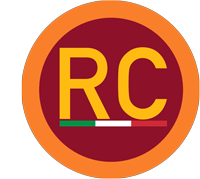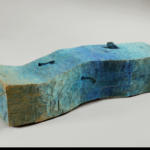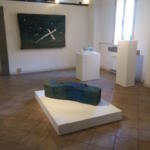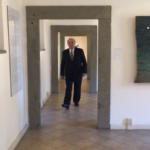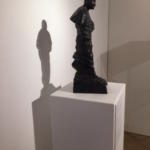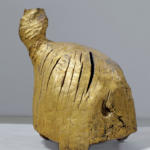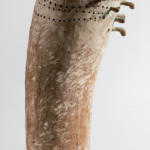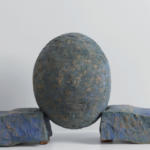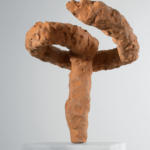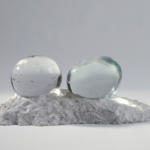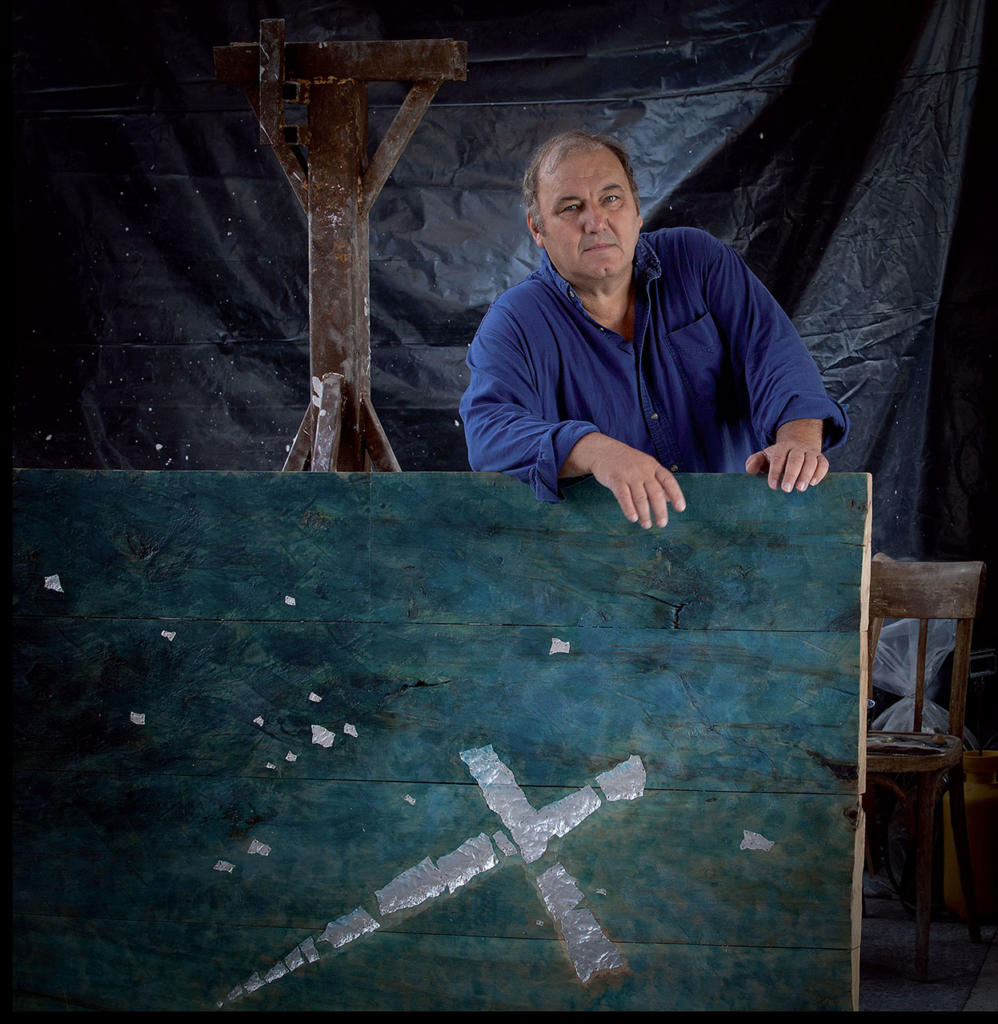 We met Maestro Sculptor Kuzma Kovačić at his first great exhibition in Rome at the San Salvatore Museums in Lauro-Museo Donazione Umberto Mastroianni. Defined as “Michelangelo of Croatia”, Kuzma Kovačić is a rare example in the contemporary visual arts of the western world. The first thing to do is lightness in his works, as well as heavy materials such as wood, glass, bronze, iron, cement, plaster, stone and marble. A realism full of poetry in which he recalls the cultural and artistic history of his country and the Mediterranean. His sculptures, strongly inspired by the Croatian tradition, send us their soul and talk to us are full of perceptual poetry. Material, carved, shaped, manipulated, transmits emotion to light. Color also appears light of a unique creativity, creating volume and mass with different expressive shapes. His research continues on the discovery of new sculpture spaces. His works are heavily impregnated in the religious spirit, have a light soul and remind us of beauty and poetry and make us move away from a chaotic world, a silent moment between works.
We met Maestro Sculptor Kuzma Kovačić at his first great exhibition in Rome at the San Salvatore Museums in Lauro-Museo Donazione Umberto Mastroianni. Defined as “Michelangelo of Croatia”, Kuzma Kovačić is a rare example in the contemporary visual arts of the western world. The first thing to do is lightness in his works, as well as heavy materials such as wood, glass, bronze, iron, cement, plaster, stone and marble. A realism full of poetry in which he recalls the cultural and artistic history of his country and the Mediterranean. His sculptures, strongly inspired by the Croatian tradition, send us their soul and talk to us are full of perceptual poetry. Material, carved, shaped, manipulated, transmits emotion to light. Color also appears light of a unique creativity, creating volume and mass with different expressive shapes. His research continues on the discovery of new sculpture spaces. His works are heavily impregnated in the religious spirit, have a light soul and remind us of beauty and poetry and make us move away from a chaotic world, a silent moment between works.
His exhibition in Rome, “Pellegrino in sculpture”, is intended to present the work of a contemporary Christian inspiration artist who derives from faith and which models faith, a rare example in the contemporary visual arts of the Western world.
The exhibition, by Milan Bešlić, includes a significant selection of works by the author of a selection of the most important creations of Kovačić and counts 46 sculptures mainly made of durable materials and 15 large photographs of public monuments or sculptural works sacred A total of sixty objects. The works come from Croatian galleries and public museums, from private collections and from the author’s collections, while the public works proposed through the photographs are found in churches and public spaces in different locations in Croatia and neighboring Bosnia and Herzegovina.
“I think his works I saw were devoid of the intervention of the Holy Spirit …”: this is the motto drawn from the fishery and speeches of the Croatian poet of Hvar Petar Hektorović (1487-1572) chosen to represent the exceptional art Sculpture by the Croatian artist Kuzma Kovačić
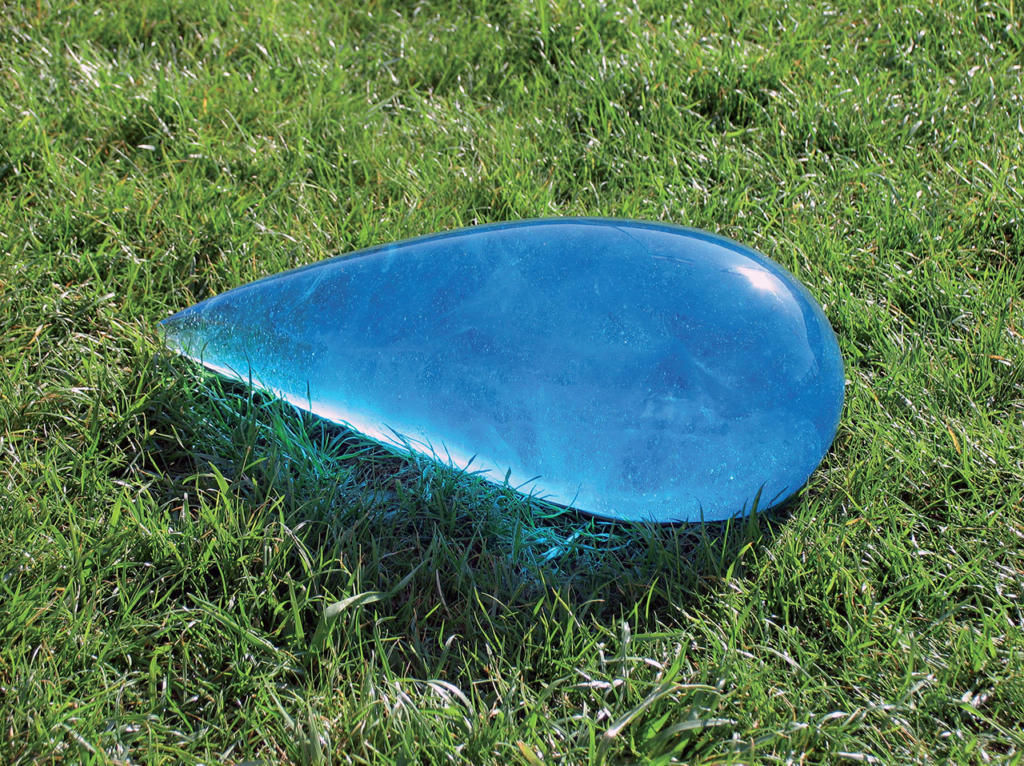 Interview with master sculptor Kuzma Kovačić
Interview with master sculptor Kuzma Kovačić
1) Do we talk about her master, how does her research begin, and her inspiration?
From childhood, my research starts from faith, our Christian faith, Catholic, which inspired me in all the impulses of life, so also in art. In youth, in high school, I began to look for art in the art of confirming those inspirations of the tenderest age. Then I realized that faith and art are two so close that, at least from my point of view, one can not do without the other. At the general, historical, or civil, cultural level, this is obvious, but at the personal level it is felt and lived, it is the very essence of life.
2) How is the exhibition project born in Rome what is it for her?
This exhibition is first of all the fruit of the desire that comes from my heart. The artist, after all, creates his own works for others, so I wanted to show her outside of my homeland and just in Rome, the center of Christianity, the centerpiece of European culture, Christianity, still today. I wanted to show here in Rome that even in contemporary art can be witnessed for Christ, for our God, despite the distances that have been rising in the last two centuries between art and faith (church), and that can be done With the language of fine arts, with the beautiful language of sculpture, that ancient but always young art. Just as our faith is old and eternally young, Sant’Agostino also said it! With my sculptural art I wanted to open a new page of sacred art. Simply from the beginning I defended sculpture as such, that is, the sense of human creativity in general. And I knew that my thought could be better understood in Rome, for all the reasons I listed, thus becoming a fact that art of our times needs.
Less than three years ago, here in Rome, at the Pontifical College of St. Jerome, the monograph on my works was presented, and that moment gave way to the initiative to organize my exhibition. The Embassy, the Embassy of the Republic of Croatia at the Holy See, was involved in the agreements. During these contacts, the initiative was also informed by the Pontifical Council for Culture, or its President, Cardinal Gianfranco Ravasi, who have recognized in this exhibition the values for which the Council has granted its patronage. Subsequently, they joined the Ministry of Culture of the Republic of Croatia and the City of Zagreb as co-sponsors, and as co-organizer the Croatian Museums by Ivan Meštrović. All this was followed by the Ministry of Foreign Affairs and European Affairs of the Republic of Croatia, with the support of other institutions and other individuals, particularly those who have granted the works in their possession for the exhibition.
This exhibition for me represents a great dream realized after having been caressed for a long time. And it is the place and moment of rest, in which I can speak publicly and testify directly – “Explain the hope we bring within us”, in the language of art, the language of sculpture.
3) A magical and dreamy realism, how do you define yourself personally?
In the strictly formal sense, the concept of realism does not correspond to the nature of my art, but in part it can explain the characteristics of my sculptural poetry and the sense of its process. This is because I do not mean the essential part of the work, its meaning, purely as a means, but as its true reality. And magic, charm or wonder distinguish every poetic or artistic creation. Likewise, that dreamlike element was not mistakenly quoted, because without dreams, without a lively fantasy, without the inventive, I would never have seen living my works, so the others would not have seen them either.
4) Describes a typical day at work, and what techniques does it use most?
I suppose the question refers to a kind day in my studio. There I work less complex, technically speaking, but creative from a decisive point of view. I work at that old, always the same, beautiful sculptural craft, to which the First Sculptor also worked: in clay form living beings! Of course, I make the casts and make shapes even in plaster (the second ancient and irreplaceable sculptural matter), chisel, shrink and so on … I prefer to concentrate on one job for the whole day, whether it be definite drafts or definite forms, but If the circumstances so require, I can also do things “simultaneously”. I work silently and approach my work as if it were a prayer. I prefer, of course, to work with daylight, but some things work gladly at night. During the job I take more pauses, then I read or something, design. While I work, I prefer not to eat, I just drink water and I light the pipe. A large and constant concentration is essential, which lasts for a long time.
For my sculptures I used many different materials because sculptures can be made of any material, but not every material can be used to make every sculpture. And each of my sculptures is a “world apart” looking for its own, special “incarnation”. So I used natural materials, classics for sculpture: wood, stone, bronze, glass, terracotta … just like “non-sculptural” ones: paper, sponge, artificial materials, up to water, color …
5) A close relationship with religion, as the artist interprets it through his works?
Since the world is a world and since man is in the world, art expresses man’s relationship with the transcendental, the plan of understanding the religious world, the one of faith, invisible, that with art instead Becomes visible. Art is the expression of the spiritual reality that man lives in, in which he lives. But especially since he has forever abstained the Apollo Priestess, Pizia, declaring that he has nothing more to say, thus admitting the historical victory of Christianity over paganism, the close bond between art and faith came in two Flourishing millennia for the art and culture of our world, the flourishing of the humanity of our western civilization (let’s leave the misfortunes that man in his weakness is able to provoke at all times!). The whole art of the West, from ancient times to the present, is Christian. Even what we call “contemporary art” in its essence, its language and its “cultural origin” is inevitably Christian, even when it does not want to be. We can therefore deduce that with the language, in this case the language of fine arts, the artist can authentically express the proximity and the bond of those realities in his works.
6) What emotions do you want to give to your exhibit?
Joy (of faith), certainty (of truth), transport (from beauty), excitement (for creative adventure), tranquility (of artistic harmony) and love (towards God and man, people and homeland) … everything that makes man a particular being, to be “in the image of God”, what makes him really happy and that he needs vitality for him.
7) These light but heavy works give us pure beauty and love, with them it seems to get out of the confusion of the modern world for a moment …
Art has always done it, protecting man from all confusion and disorder, introducing it into the spaces of harmony and joy. Even when he uses the processes that disturb him, his end remains the good of man. Indeed, the relationship between the body, the material and the spiritual of art tells us that true reality and true freedom are not found in material, but in what art alone, through its particular possibilities and “authority” Makes us visible.
8) What Future Projects?
I would like to bring this exhibition to some other European cultural center, in front of the most demanding audience. And I would also like to expose it to where Christianity is in peril, like the Holy Land.
At home, in the capital city of Zagreb, a monument to the founder of the modern Croatian state, Dr. Franjo Tudjman, and Jajce, the old Croatian real city located in Bosnia and Herzegovina, the construction of the altar, the amphitheater , The tabernacle, and the baptismal church for the new church.
9) What do you want to accomplish?
My desire is to bring the enthusiasm for creativity and, in particular, to sculptural art among the same sculptors, especially students, and to give people the joy that art brings to us. This can not be achieved without respect for our predecessors, so I try to preserve for the future all the best from the entire sculptural tradition and especially the national one. Therefore, in the years that I remain, I will try to work in that way and to bear witness to the confessional dimension, the fundamental and the value of the act of creation and the same work of art.
10) And to finish, the thrill of exhibiting the first time in Rome, the cradle of culture.
I feel like I’ve been to Rome forever since I am aware of the importance of cradle in the life of man and mankind – the cradle of Mediterranean and Christian culture, and at the same time I feel like that pilgrim from Croatia that Dante mentions in Divine Comedy, which came “to see our Veronica”, touched by that emotion to the marrow of my human existence. And of course, I am proud to have the honor of representing Croatian art today in Rome, with the exhibition under the High Patronage of the Pontifical Council for Culture.
Kuzma Kovačić: The exhibition
The result of a collaboration between the Embassy of the Republic of Croatia at the Holy See and the Museums Ivan Meštrović, the exhibition enjoys the patronage of the Pontifical Council for Culture, in the person of Cardinal Gianfranco Ravasi, and the Co-patronage of the Ministry of Culture Republic of Croatia and the City of Zagreb. In the year in which the 25th anniversary of the recognition of the Republic of Croatia and the establishment of full diplomatic relations with the Holy See is celebrated, it is proposed to promote contemporary Croatian art in Rome, the center of Christianity and the European center Of culture, with works coming from a country rich in Christian and Catholic artistic heritage and a people who live in faith.
The relationship between Art and Faith, which he himself has emerged for four decades in the hundreds of works created – from the famous door of the Cathedral of Hvar to the coins of the Republic of Croatia, from the imposing monuments in the public spaces of his country, Altar of the Croatian Homeland, to the mastodontic reliefs in the sacral places – also draws a positive message of reunion between the two worlds: according to the intent of the organizers, in fact, “the exhibition may perhaps offer an answer to the secular question about the division between the Church and Art, proposing a new possible union in the service of the civilization of life, of life with God. ”
The exhibition, scheduled until May 20, is inaugurated by Dominique François Joseph Cardinal Mamberti, Prefect of the Supreme Court of the Apostolic Signature.
KUZMA KOVAČIĆ – Biography
The contemporary Croatian sculptor Kuzma Kovačić was born on June 6, 1952 by Vinko and Jelena, born Novak, in the old town of Hvar, on the island of the same name in the central part of the Adriatic, in a particularly mediterranean landscape that strongly influenced the childhood And the youth of the sculptor, whose traces are detectable in his many works. After graduating high school, Kuzma Kovačić leaves Hvar with a sense of deep belonging to the Mediterranean environment and with the Christian conception of the world acquired in the family, to land in Zagreb in 1971 in a period of heavy communist repression, where he enrolled in sculpture all Academy of Fine Arts and graduates in 1976. Since the beginning of his business, he has been able to find his own way in sculpture and begins to exhibit his works, trying to defend and renew the values and the specificity of sculptural art and To witness their faith by means of sculpture. After marrying in 1978 Barbara Domančić from whom she has a son, Vinko, born in 1980, and a daughter, Petra, born in 1983. She organized her first solo exhibition in 1979 in the Museum of the City of Šibenik where her exhibitions First works of Christian inspiration, a spirit that has permeated since its inception the essence of its sculptural form: Seven Sins of Capital (1987), Here the sea suffers sweat of blood (1977), The Saint’s sermon on fish Rimini (1979).
A year later, in 1980, he obtained a scholarship from the Italian government for Murano where he knew and perfected the art of glass in the “Aldo Nason” and “Fratelli Manfren” glassworks and created his first glass sculptures. Throughout the decade since the ’80s, the artist was a highly productive creative period, with works of great importance including: Epistle to Mavro Vetranović (1980), Thanksgiving to the Benedictines (1983), For the body (1985), Very bitterly (1988), Dialect of Tea in Sculpture (1988) and others. Towards the end of the 1980s, he began his first pilgrimage to the Holy Land and to Rome, to later visit Lourdes, Loreto and several other places of pilgrimage of the country and of the way. The decade of the 1990s is marked by a work that, in addition to being one of his most important sacred sculptures, was also his first great public sculptural realization. It is the Gate of the Hvar Cathedral (1990), which has not only provoked a positive reaction from the lover of culture, but has also been emphasized by critics as a masterpiece of contemporary sacral sculpture and a new sign of renewal of sacred art Croatians. Since then he has produced more than a hundred public or sacred sculptures. In the years 1991 and 1992 he made the processional Crucifix for the Cathedral of San Doimo in Split.
He made the first monument in honor of Franjo Tudman, the first Croatian Democratically elected President, founder and defender of the Republic of Croatia, who is also the most successful work of the genre according to the unanimous judgment of art critics and the passionate Croatian audience of culture. The monument was erected in 2001 in Škabrnja, a small symbol of great suffering during the Patriotic War. In 2009 she participated in the exhibition “Contemporary Croatian Sculpture” organized by the Glittoteca of the Croatian Academy of Sciences and Arts and subsequently also presented in Germany, Austria, Italy, Slovakia, Hungary and Slovenia.
In 2012, she is a member of the Croatian Academy of Sciences and Arts. In addition to this award, she has been awarded numerous prizes and awards, including three state honors. And in 2013 he presents himself to the Croatian public with a recent selection of his own artistic production at the retrospective exhibition in Zagreb, in the Gallery of Modern Art, and later in Split at the Art Gallery. In the same year the monograph on his artistic work was published, which in 2014 will be presented also in Rome, at the Pontifical Croatian College of St. Jerome. From 2014 to 2016 it carves with its collaborators the altar relief Glory of Croatian Martyrs, which in August 2016 is placed in the Church of Croatian Martyrs in Udbina. It is one of the greatest stone reliefs in stone not only in the Croatian area and, undoubtedly, in a work of impressive aesthetic reach and symbolic intensity. On the occasion of the inauguration ceremony and blessing of the relief, the sculptor said, as he had repeated many times earlier in oral and written form, that he expresses his Christian faith by means of figurative language, witnessing his own sculptural activity that the Word has become work.
www.kuzma-kovacic.from.hr
She is an independent curator, art advisor and international marketing management consultant. For more than 20 years, he has been a cultural designer of events related to contemporary art with particular attention to unusual spaces and interactions with other arts.
